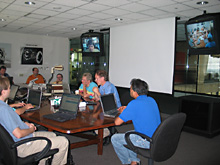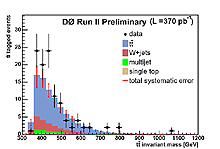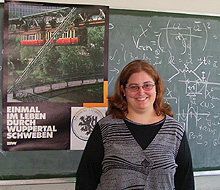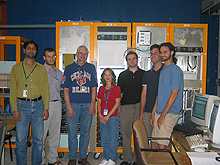 | Thursday, September 1, 2005 |
|
Thursday, September 1 3:30 p.m. Director's Coffee Break - 2nd Flr X-Over 4:00 p.m. Accelerator Physics and Technology Seminar - 1 West Speaker: H. Tomizawa, SPring-8, Japan Title: R&D on RF-Gun Photoemission Sources at SPring-8 Note: There will be no Theoretical Physics Seminar this week
Friday, September 2 |
|
Extended Forecast |
Secon Level 3 |
|
Thursday, September 1 - Tomato Florentine - Grilled Chicken Cordon Bleu Sandwich - Chimichangas - Chicken Marsala - Smoked Turkey Melt - Italian Sausage Calzones - SW Chicken Salad with Roasted Corn Salsa The Wilson Hall Cafe now accepts Visa, Master Card, Discover and American Express at Cash Register #1. |
|
Thursday, September 1 Dinner - Caponata - Grilled Scampi - Orzo with Arugual and Parmesan - Cassata
Wednesday, September 7
Chez Leon Menu |
| Fermilab Today is online at: http://www.fnal.gov/today/ Send comments and suggestions to today@fnal.gov Fermilab Today archive Fermilab Today PDF Version Fermilab Result of the Week archive Fermilab Safety Tip of the Week archive Linear Collider News archive Fermilab Today classifieds Subscribe/Unsubscribe to |
| The Art of Monitoring with MonALISA Operating a successful grid, network or computing facility requires vast amounts of monitoring information. Projects and organizations worldwide that need to track resource usage, network traffic, job distribution and many other quantities rely on Caltech's MonALISA system to collect the information and present it in a way that allows them to make effective decisions. The system also automatically troubleshoots and optimizes very large grid and network systems.
"While developing computing models for experiments at the Large Hadron Collider, we realized that vital monitoring information was missing," explained Caltech's Iosif Legrand, MonALISA's chief architect. "We didn't want to reinvent the wheel, so we built a framework that collects and synthesizes data from many existing monitoring tools and built new tools only where needed."
|
|
From ESA Space Science, August 31, 2005 XMM-Newton probes formation of galaxy clusters ESA's X-ray observatory, XMM-Newton, has for the first time allowed scientists to study in detail the formation history of galaxy clusters, not only with single arbitrarily selected objects, but with a complete representative sample of clusters. Knowing how these massive objects formed is a key to understanding the past and future of the Universe. Scientists currently base their well-founded picture of cosmic evolution on a model of structure formation where small structures form first and these then make up larger astronomical objects.
Galaxy clusters are the largest and most recently formed objects in the known Universe, and they have many properties that make them great astrophysical 'laboratories'. For example, they are important witnesses of the structure formation process and important 'probes' to test cosmological models.
|
| Using Top to Search for Technicolor |
||
|
||
|
Of all the quarks, the top quark is perhaps the most mysterious. While supposedly an infinitely small point particle, it has the mass of 175 protons. The high value of the top mass has led to speculation that the top quark plays a special role among the elementary particles that is not reflected in the Standard Model (SM) of particle physics. Theorists have hypothesized extensions of the SM that predict modifications of the top quark's properties.
Of particular interest is the distribution of a quantity called the "invariant mass" of top-antitop quark pairs (which we refer to as t-tbar). It is especially sensitive to modifications of the SM that predict additional ways to produce these t-tbar pairs in the high energy proton antiproton collisions studied at the Tevatron. For example the production of a Z prime (an extra heavy cousin of the photon) would appear as a spike in the t-tbar invariant mass distribution. DZero has measured the invariant mass of t-tbar and compared the results to the SM prediction. The measured distribution is consistent with the SM expectation. Thus limits on the branching ratio times cross-section for resonances can be set as a function of the resonance mass. One particular extension of the SM referred to as Technicolor has been used as a benchmark model for comparison. In this model Z' masses up to 680 GeV are excluded at 95 percent confidence level, an impressive 120 GeV improvement over the world's previous best limit. |
||
|
||
|
||
| Result of the Week Archive |
|
August 29 - August 31 - During this forty-eight-hour period Operations established one store that combined with an existing store provided the experiments with approximately 44 hours and 15 minutes of luminosity - New Pbar stack record for the Recycler Ring is 191.0 E10
Read the Current Accelerator Update
|
|
Power Outage Due to the holiday weekend, the September 3 power outage has been rescheduled to September 24th. The power will be cut to Labs A, B, C, D, E, and F from 8:30 AM - 4:30 PM on Saturday, September 24, 2005.
Weekly Time Sheets Due Tomorrow
Opening Night - Natalie MacMaster
|



